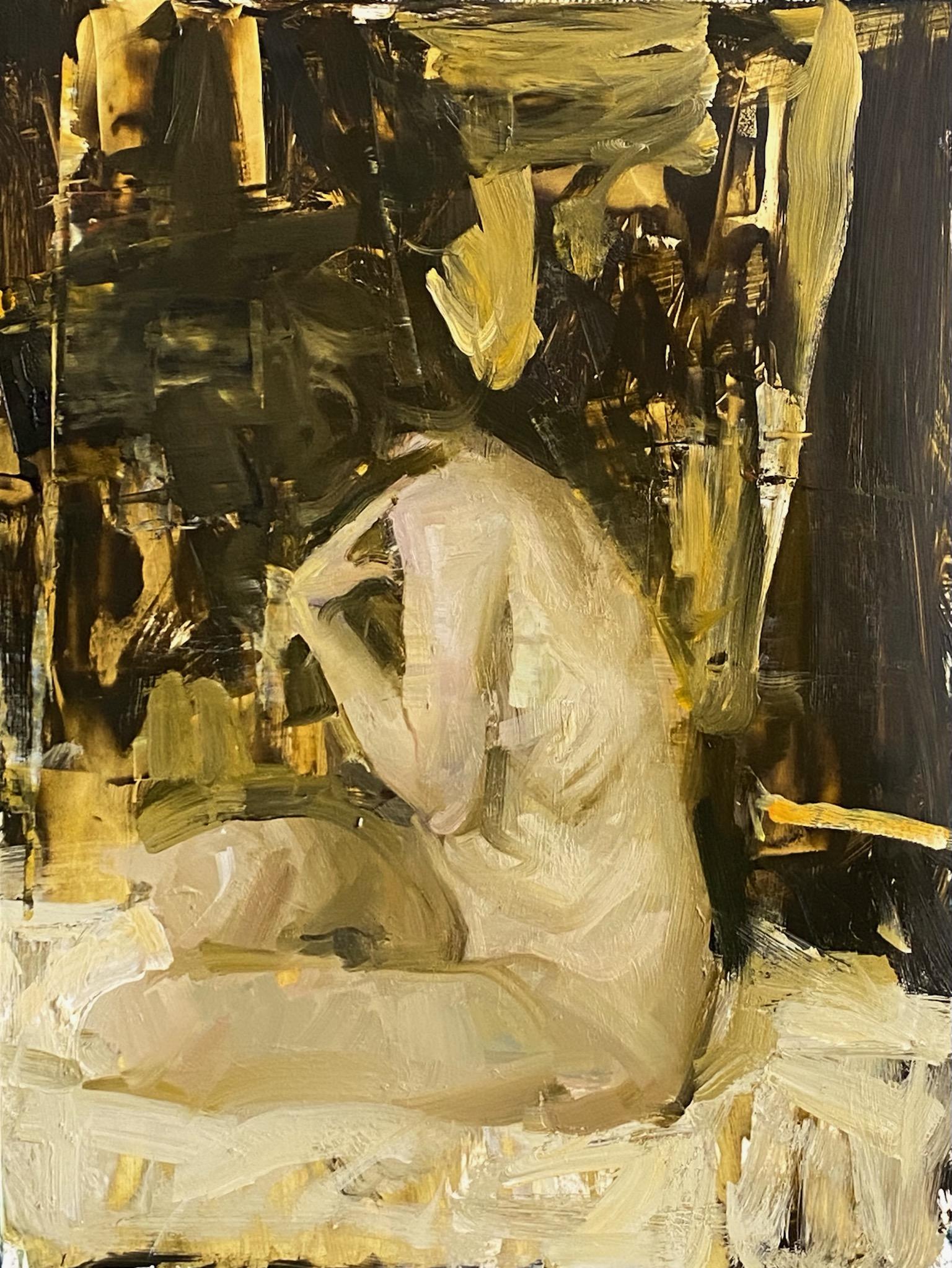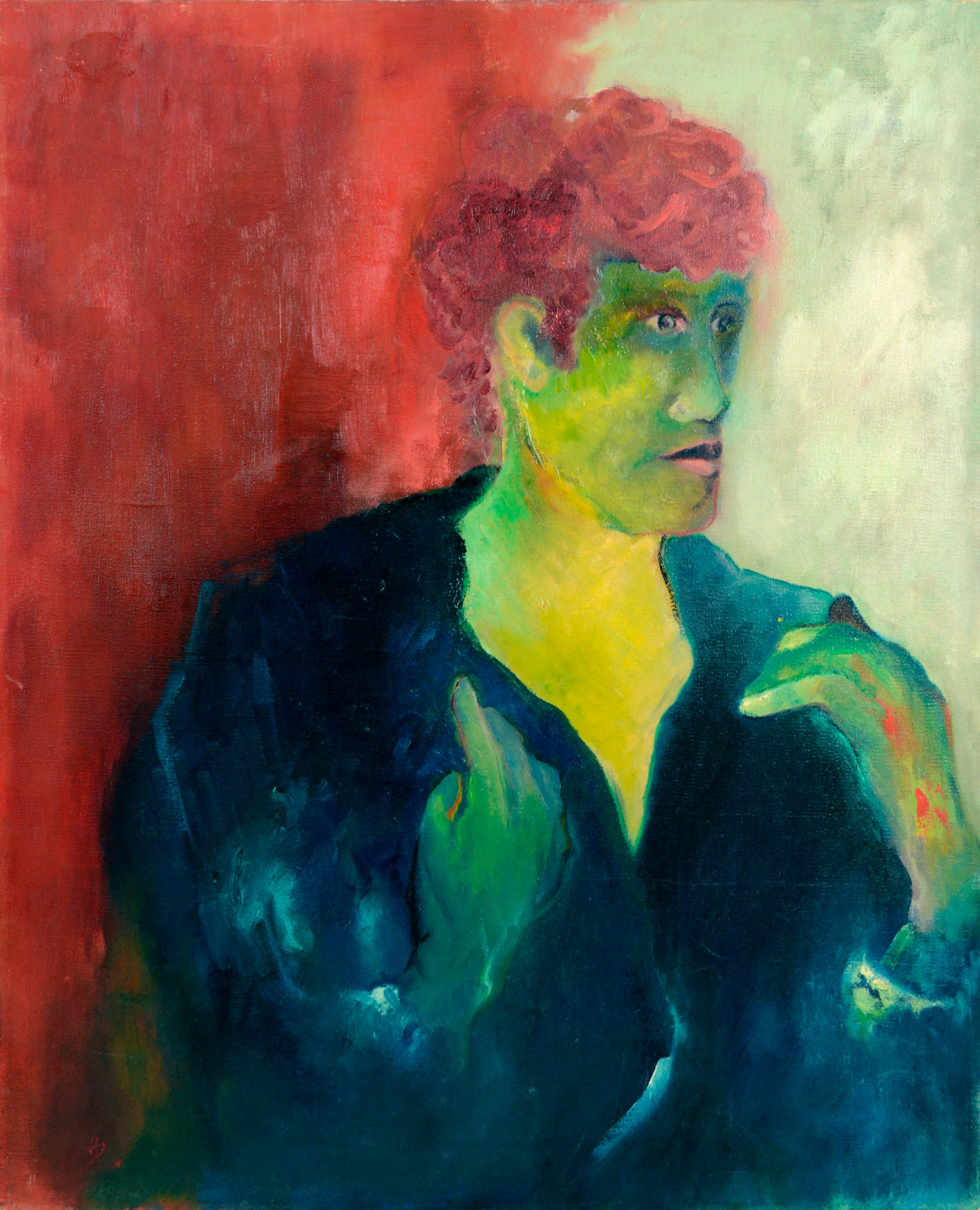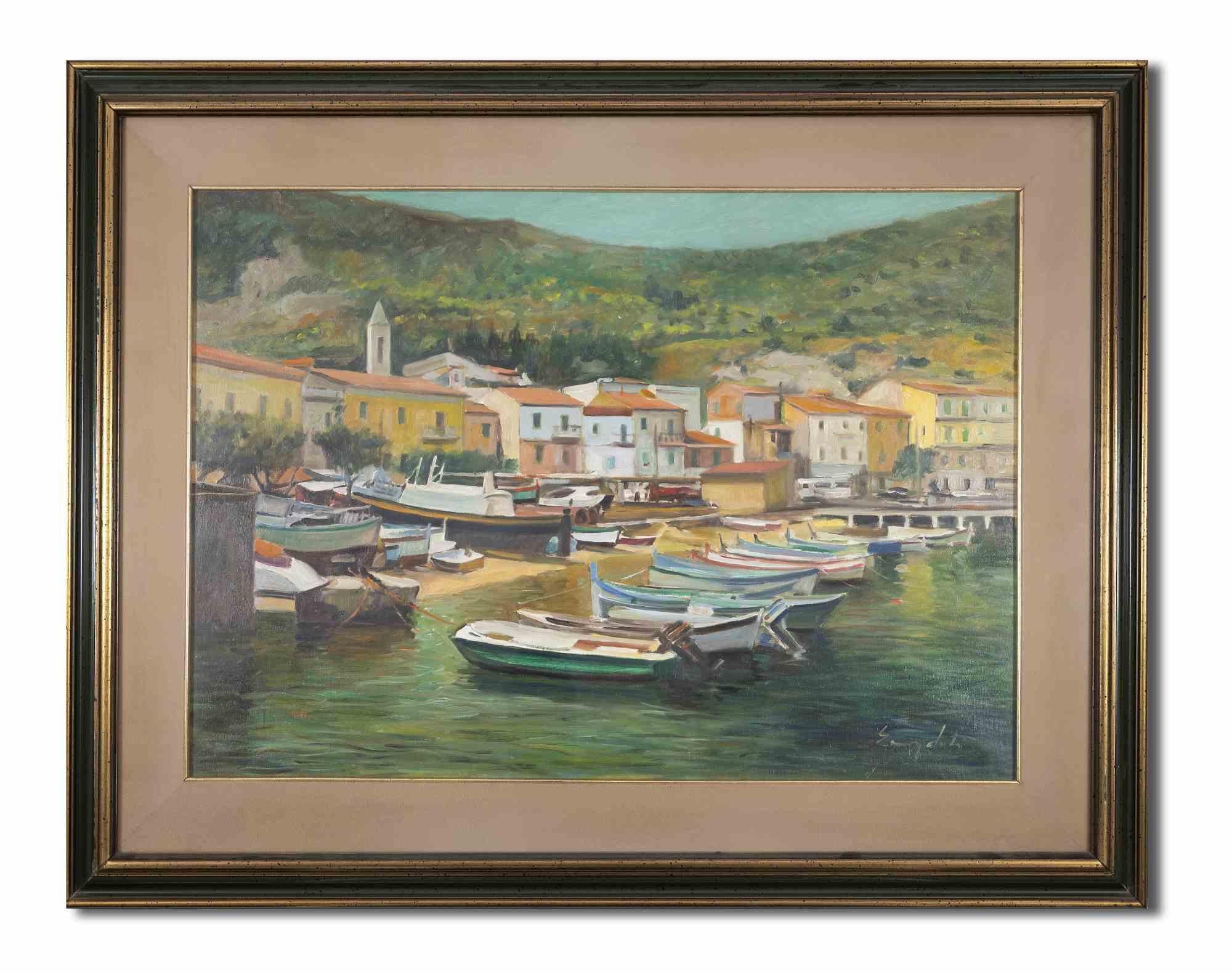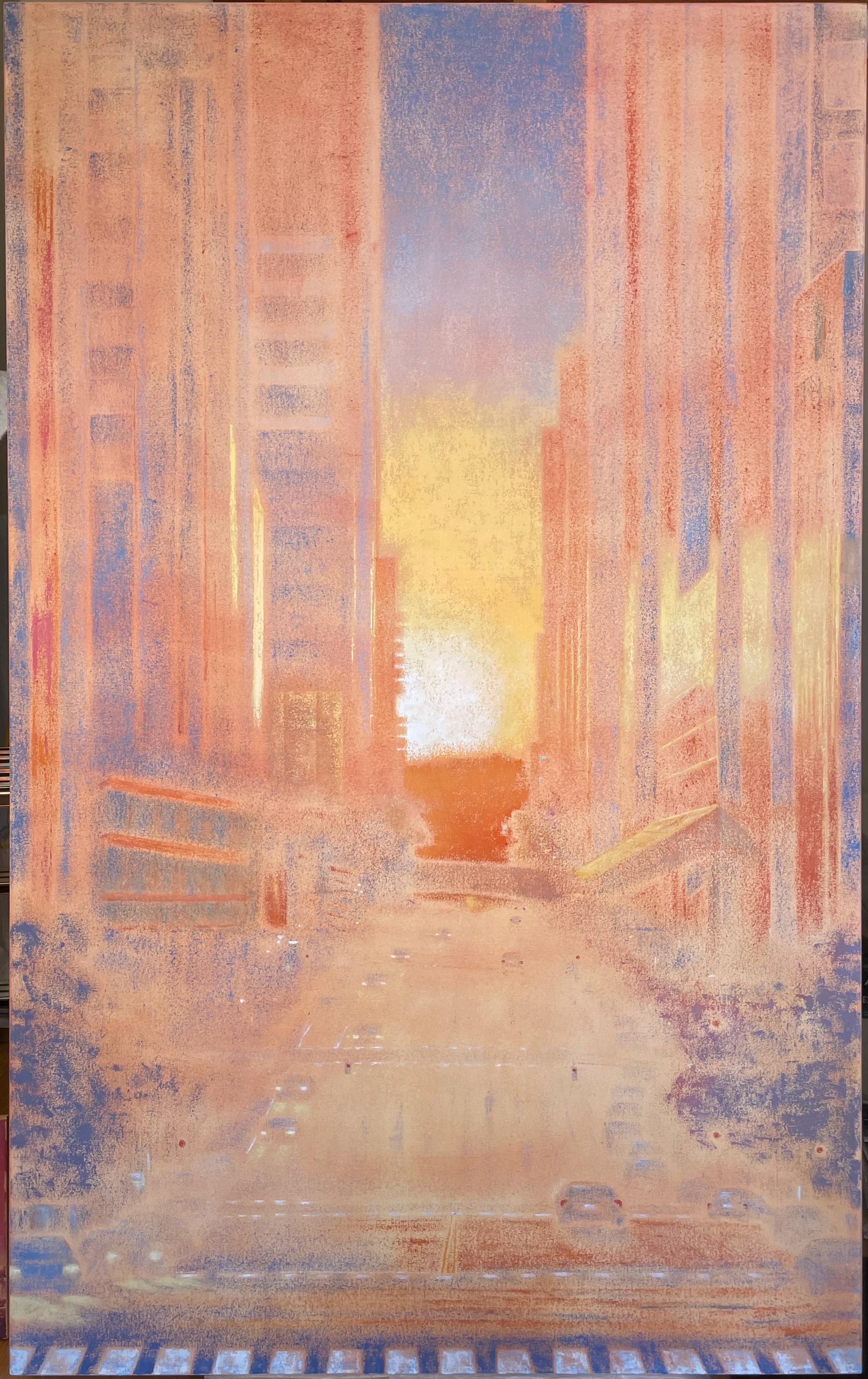Items Similar to La Poste 1954 PARIS - Post Impressionist street scene
Want more images or videos?
Request additional images or videos from the seller
1 of 8
Jean SalabetLa Poste 1954 PARIS - Post Impressionist street scene1954
1954
About the Item
Jean Salabet
French, 20th Century
La Poste
Jean Salabet was a School of Paris painter know for his colorful Parisian cityscapes.
His work is comparable to those of Jules Herve, Antoine Blanchard and Edouard Cortes.
Juan Bayón Salado, Bay-Sala, J. Bayon, J.B., Jean Salabet (1913-1995)
A Biscayan artist, Juan Bayón Salado (Jean Salabet), was born in Logroño on June 24th, 1913. He died in Bilbao on April 2nd, 1995.
In 1918 he moved to Bilbao. In the early 1930s, he installed his easel at the Bilbao Arenal, where he painted and raffled his paintings among the attendees in order to help his parents. At the time he used to sign as Bayón, and soon after he became a benchmark in the area. According to the painter Manuel de Gracia:
In 1941 he celebrated his first exhibition in Bilbao and a year later he exhibited in Zaragoza, where for the first time he used the pseudonym Bay Sala as signature of his works; that same year he also exhibited his works in Logroño and Bilbao. In 1943 he attended the Exposición Nacional de Bellas Artes with the painting Puerto de Motrico and held exhibitions in Barcelona and Bilbao. Two years later his work La Mina Abandonada was present at the Exposición Nacional de Bellas Artes. That same year he presented himself at the Primera Exposición Provincial de Bellas Artes in Bilbao with the works Riberas Frondosas and La Mina Abandonada and he obtained the Excmo. Ayuntamiento de Bilbao’s gold medal. From that date onwards he hasn’t participated in any other contest.
In 1945 he was a founding partner of the Asociación Artística Vizcaína. In 1948 he participated in the exhibition "35 Paisajes Vascos" at the Witcomb Gallery in Buenos Aires; also making his presentation in Madrid. In the spring of 1950 he set off for Paris, where he settled his residence until the end of 1969 in search of the roots of Impressionism. During those twenty years, as Manuel Lumbreras indicates, he:
"exhibits regularly at the Roussard Gallery in Paris, as well as at the Salon Cano in Madrid and at the former Sala Arte of Bilbao. He is summoned from Buenos Aires and Tokyo and he is selected, along with 35 other artists, to cover the 16th and 17th editions of the Salon de Toile in Paris, together with such eminent artists as Cocteau, Dalí, Dufy, Picasso, Utrillo and Vlaminck, among others. His works become part of the most important international collections around the world."
In 1968 he held exhibitions in Tokyo and Paris. A year later, he returned for good to Bilbao, where he regularly held exhibitions, as well as in Madrid and Barcelona; he also spent long periods painting in Holland, France, Italy, USSR, Belgium and Ireland.
In 1971 his son Juan Bayón opened a small gallery on Iparraguirre street, under the name of Bay Sala, presenting a collective exhibition with the works of A. Alegre, Bardasano, Bay Sala, M. de Gracia, C. Gil, Herráez, Largacha, Luzuriaga, Martínez Díaz, Olaortúa, R. Calpena, J. Quesada and R Sáez. In October 1975, the gallery moved to Licenciado Poza street, 14. The inaugural exhibition of this new space is a tribute to four Basque artists who obtained medals at the Exposiciones Provinciales de Bellas Artes: Bay Sala, Largacha, Merino y Párraga. To this exhibitions followed many individual and collective exhibitions by artist such as Anglada, Benedito, Madrazo, Pradilla, Martín Rico, Lucas Padilla, Marceliano Santa María, C. Pía, Pérez Villamil, Picasso, Grau Sala, Puigdengolas, San Vicens, Millares, Amat, Mallol, Pichot, R. Domingo, Muñoz Degrain or Martínez Vázquez among many others. Among them, Juan Bayón's work is regularly displayed in the gallery.
With a group of painter friends Bay Sala created the talks of "La paleta del Nervión". As a result of this idea, the "Paleta de Oro del Nervión" trophy was created. It is periodically awarded to the most outstanding artists. Among them, Bay Sala himself (1984), Martínez Díaz, Largacha, Juan Manuel Lumbreras and Manuel de Gracia.
In 1985 he was invited to the exhibition "Maestros Actuales de la Pintura Española" for the inauguration of The Embassy gallery in Miami, Florida. In 1991 he was appointed Honorary Fellow of the Asociación Artística Vizcaína. His works are in the Museo de Bellas Artes de Bilbao and in the Museo San Telmo of San Sebastián, among others.
Sources include:
Enciclopedia AuñamendiDictionnaire des Peintres a Montmartre (pp.55-56 ...He signed Salabet, Bay Sala and Bayon)Legacy Copyright Jean SalabetCatalogue Galeria Bay-Sal (J. Salabet- Pseudonym of J. Bay-Sala)
Oil on canvas
10/1/4 x 13/3/4
Signed lower right
Provenance:
Private Collection, Massachusetts
Le Trianon Fine Art & Antiques, Sheffield, MA.
Art S200
$3,600
- Creator:Jean Salabet (French)
- Creation Year:1954
- Dimensions:Height: 16.5 in (41.91 cm)Width: 19.5 in (49.53 cm)Depth: 2 in (5.08 cm)
- Medium:
- Movement & Style:
- Period:
- Condition:
- Gallery Location:Sheffield, MA
- Reference Number:
Jean Salabet
Jean Salabet was a School of Paris painter known for his colorful Parisian cityscapes. His work is comparable to those of Jules Herve, Antoine Blanchard and Edouard Cortes.
About the Seller
3.7
Vetted Seller
These experienced sellers undergo a comprehensive evaluation by our team of in-house experts.
1stDibs seller since 2017
46 sales on 1stDibs
- ShippingRetrieving quote...Ships From: Sheffield, MA
- Return PolicyA return for this item may be initiated within 3 days of delivery.
More From This SellerView All
- Moonlight Over the PromenadeLocated in Sheffield, MAWilhelm von Gegerfelt Swedish, 1844-1920 Moonlight Over the Promenade Oil on canvas 27 by 45 in. W/frame 39 by 57 in. Signed lower right Wilh...Category
Early 1900s Post-Impressionist Landscape Paintings
MaterialsOil
- Jeune Femme AlongeBy Pierre CornuLocated in Sheffield, MAPierre Cornu French, 1895-1996 Jeune Femme Alonge Oil / Canvas 14 by 18 in. W/frame 20 by 24 in. Signed lower right Pierre Cornu was born November 16, 1895 in Salon de Provence. Born into a prosperous family of merchants oils and soaps, Cornu knows a pampered childhood and happy during which his attraction to drawing and color manifests itself fairly quickly. He will have the opportunity, throughout his life to be able to concentrate on his passion of painting. His paintings are often honored in all the great Parisian salons. He exhibits regularly with René Auguste Chabaud and Seyssaud in Marseille. Financial troubles forced him to emigrate several years in Morocco where he begins a new life, never abandoning painting, perfecting his art (abundance of beautiful colors, resembling oriental tapestries...Category
1930s Post-Impressionist Figurative Paintings
MaterialsOil
- Vue De VeniseBy Henri DuvieuxLocated in Sheffield, MAHenri Duvieux French, 1855 – 1920 Vue De Venise Oil on canvas 15 ¾ in. by 25 ½ in. W/frame 25 ¾ by 35 ½ in. Signed lower right Henri Duvieux was an artist influenced by the intere...Category
1880s Post-Impressionist Landscape Paintings
MaterialsOil
- Twilight along the River BendBy Louis Aston KnightLocated in Sheffield, MALouis Aston Knight New York/California/France, 1873-1948 Twilight along the River Bend Oil on canvas signed lower left"Aston Knight/Paris" 26 by 32 in. ...Category
1920s Post-Impressionist Landscape Paintings
MaterialsOil
- A Venice CanalBy Charles CousinLocated in Sheffield, MACharles Cousin French, 1904-1972 A Venice Canal Oil on canvas 20 by 26 in. W/frame 28 by 34 in. Signed lower right Charles made his debut at the Sal...Category
1930s Post-Impressionist Landscape Paintings
MaterialsOil
- At The SeasideBy Gaston SebireLocated in Sheffield, MAGaston Sebire French, 1920-2002 At The Seaside Oil on canvas 25 by 31 in. W/frame 33 ½ by 39 ½ in. Signed lower right Gaston Sebire (1920 – 2002) Gaston Sebire, was one of Europe’s leading landscapists, was born in the village of Saint-Samson in Normandy in 1920. A self taught artist, he began to paint seriously at the age of eighteen. For eight years he worked as a postal clerk in the Rouen, sorting letters at night in order to support his career as a painter. In 1952 Gaston Sebire had his first exhibition at the Galerie Gosselin in Paris. The following years he enjoyed the double triumph of winning both the coveted Prix de la Critique and the Prix Casa Velasquez. The Latter award made it possible for him to spend a year and a half in Spain. Of this formative period he said, “They were my first, wonderful years without worry. For fifteen years I had never known what the next day would bring.” The year 1957 marked another important stage in his career. His painting “La Dinde” won the Greenshields Prize in a field of 136 competitors, making it possible for him to paint for another two years without the worry of finances. Winning the awards naturally drew public attention to the artist from Normandy, and his works were presented in highly successful one-man shows in Paris. Sebire was a Norman, a man strongly attached to the soil, and after his exhibitions in Paris, he returned to Rouen to his large house overlooking the town and once again plunged into painting the countryside. Gaston Sebire was a strongly built man with square hands and a rather heavy walk. He had immense vitality, and used that to his advantage. As he said of himself, “When the snow falls, I can’t stay indoors. I set out with my paint box. I paint outdoors from nine in the morning until five at night. If it were only a question of money, one could just as well paint in one’s own room.” But Sebire went into the countryside, or into the village, and sets up his easel. When there is a café into which people are going; there is a fence, a telegraph pole, a few buildings in the background. The scene takes on life, vivid life, with a sense of some event about to take place in the scene. Like many artists, and like a typical Norman, Sebire was silent and solitary by nature, with a personality as strong and frank as his paintings. A painting, he says, “must have an element of mystery, show an effort to look beyond the aura surface of things.” Sebire’s early paintings were somber with much use of black and white tones. In 1970 he turned to colour. The subtle light of the Normandy skies; the shifting light and color along the seacoast; the magnificent blues of the Rouen pottery...Category
1960s Post-Impressionist Landscape Paintings
MaterialsOil
You May Also Like
- "Figure in Gold Abstraction", Oil PaintingBy Quang HoLocated in Denver, COQuang Ho's (US based) "Figure in Gold Abstraction" is an original, handmade oil painting that depicts a pale nude female model sitting among rumpled white fabric as she delicately pl...Category
2010s Post-Impressionist Figurative Paintings
MaterialsOil, Panel
- Blue and Purple Mountains - Fauvist LandscapeBy Don KlopferLocated in Soquel, CAVibrant and playful landscape by California artist Richard "Don" Klopfer (1920-2009). Signed and dated "R. Klopfer 3.86" on verso. No frame. Board size: 13"H x 19"W Richard "Don" Klopfer (1920-2009) attended the National Art School in Washington D.C. and the California College of Arts and Crafts in Oakland, California. Klopfer was a life-long, passionate visual artist who worked in a variety of mediums, including oil paints, wood and bronze. His gallery "The Flair" was on Pico Blvd West Los Angeles from 1954 to 1980 was a gathering place for artists, friends and collectors. He was recognized for the use of brilliant color in his paintings and for leaving drawings everywhere he went. Klopfer's painting "My Old House" is on permanent exhibition at San Luis Obispo Museum of Art (SLOMA). He has also exhibited at The Los Angeles County Art Museum, Esther Robles Gallery, Third Street Gallery, Westwood Art Association, Barnsdale Park, and Robert Pyle Gallery. Selected Exhibitions: 1990 - Wild Horse Gallery - San Luis Obispo, CA 1991 - “South County Journey” - El Camino Arti Association Gallery - Pismo Beach...Category
1980s Fauvist Landscape Paintings
MaterialsOil, Cardboard
- La lecture au jardin (Lesson in the Garden)By Georges d'EspagnatLocated in New Orleans, LAFrench Post-Impressionist painter Georges d’Espagnat captures a charming moment between a mother and her child in this vibrant oil on canvas. Rendered with a studied use of complementary colors and bold brushstrokes, the painting showcases the artist's unique Post-Impressionist style. Remembered as one of the most individualistic artists of the 20th century, his distinctive canvases bring together the loose brushwork of the Impressionists and the bold color palette favored by the Fauves. Together, they achieve a vibrant spontaneity that lends itself well to the carefree subjects of the present work. Masterfully composed, La lecture au jardin moves beyond the Impressionist instinct to capture a fleeting moment on canvas. Rather, d'Espagnat succeeds in creating a deep feeling of harmony in the work. Warm colors are perfectly balanced with cool tones, while vertical and horizontal lines are softened by the curves of the foliage and his subjects' figures. Through his simplification of forms and intentional use of color and line, he creates a scene that is carefully designed and thoroughly modern. A similar view of a mother and her child by d'Espagnat is currently in the collection of the Metropolitan Museum of Art (New York). The Post-Impressionist painter was an individualist since his youth, choosing to forgo traditional schooling in order to independently study the Old Masters in the Louvre. He soon became involved with the most prominent Impressionist and Post-Impressionist painters of the age, including Pierre-Auguste Renoir and Paul Signac, who themselves existed outside the traditional norms of French Academic training. In 1891, he exhibited at the Salon des Refusés, and again the following year at the Salon des Indépendants. By 1895, he held his first one-man show in Paris, and just three years later his success earned him a solo show at the prestigious Durand-Ruel Gallery. Between 1905 and 1910 he made several trips to visit Renoir on the Côte d’Azur. Their close friendship resulted in a group exhibition at Marcel Bernheim...Category
Late 19th Century Post-Impressionist Portrait Paintings
MaterialsCanvas, Oil
- Mid Century Fauvist Portrait of a ManBy Sydney HelfmanLocated in Soquel, CAStriking and colorful mid century Fauvist portrait of a man by Sydney Helfman (American, 1926-2010). The expressive and vibrant color palette, a signatu...Category
1960s Fauvist Figurative Paintings
MaterialsLinen, Oil
- Summer Italian Harbor - Painting by Mario Evangelisti - 1973Located in Roma, ITSummer Italian harbour is an orginal modern artwork realized in 1973 by the Italian artist Mario Evangelisti. Mixed colore oil painting on canvas. Hand ...Category
1970s Post-Impressionist Figurative Paintings
MaterialsOil
- PhenomenonBy Gay Summer RickLocated in Santa Monica, CAOil on canvasCategory
2010s Post-Impressionist Landscape Paintings
MaterialsCanvas, Oil
Recently Viewed
View AllMore Ways To Browse
French Art Paris Scenes
Paris Street Sign
Together In Paris
T Post
Scene Four
Four Post
Small Paris Paintings
Paris Streets Painting
Small Impressionist Art
Impressionist Small
Impressionist Street
1995 Paris
Dior Street
Gold Framed Impressionist Art
Post Impressionist Paintings Paris
April In Paris
Post Impressionist Paintings Of Paris
Street Of Italy Painting






